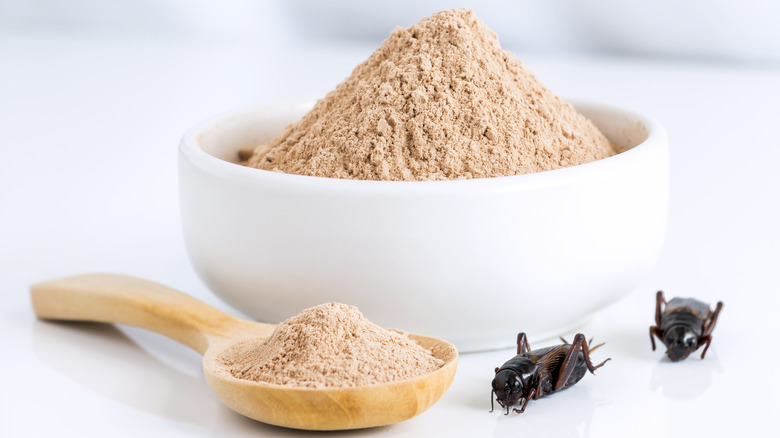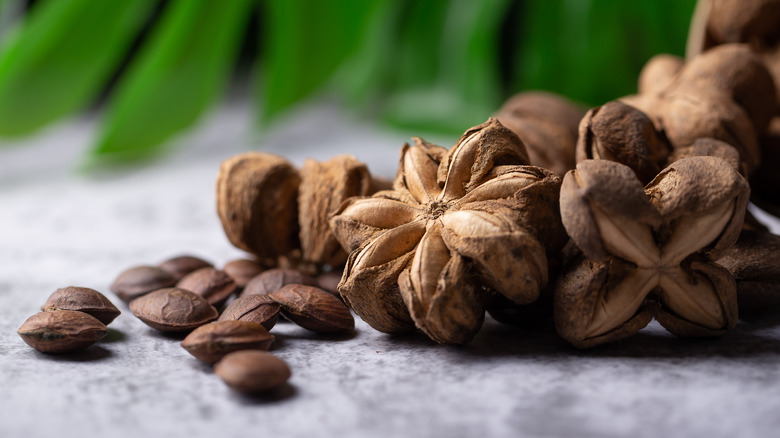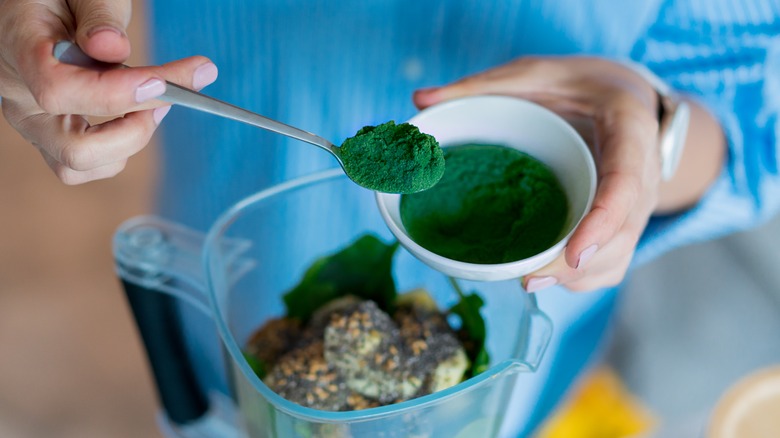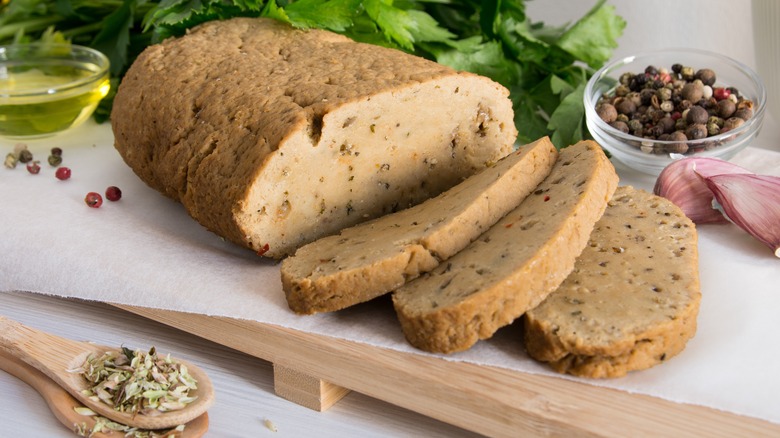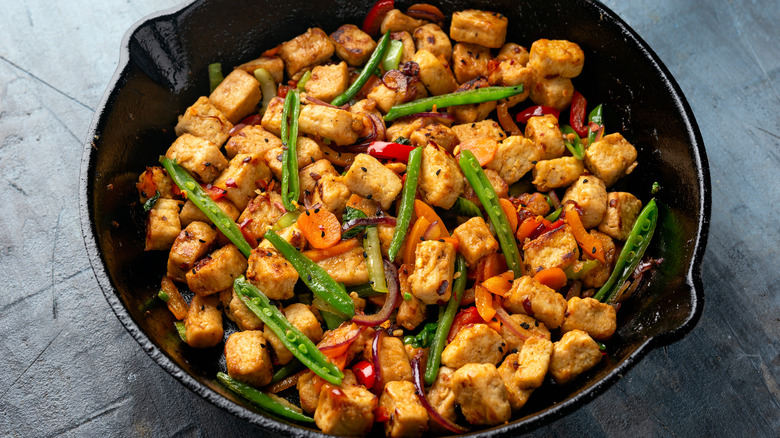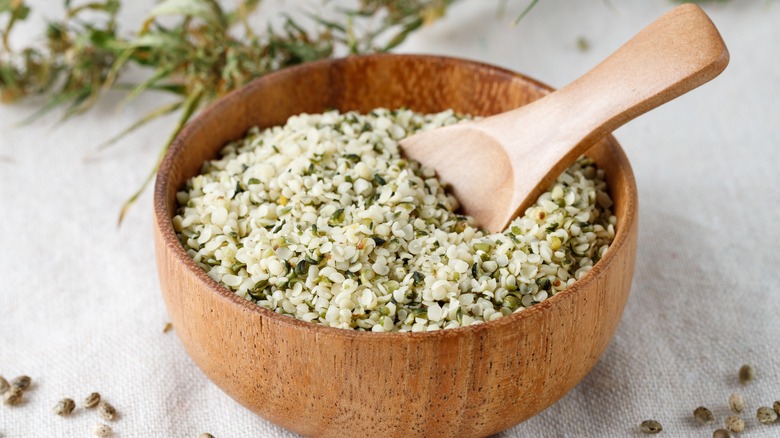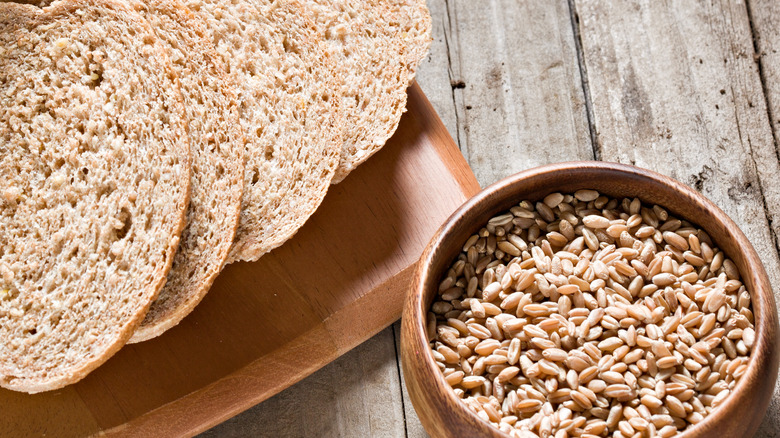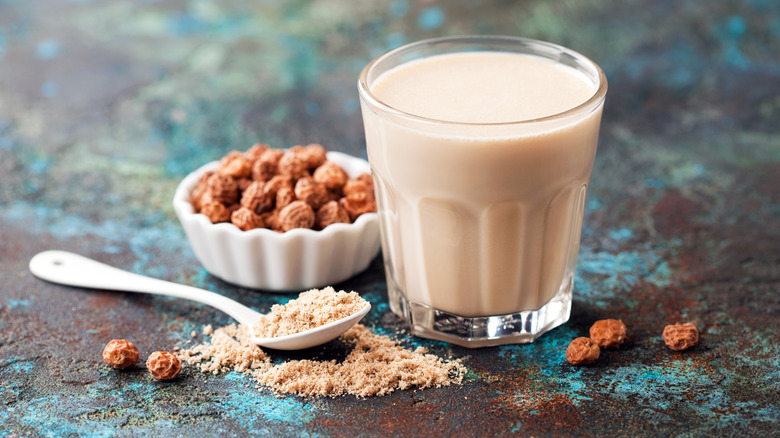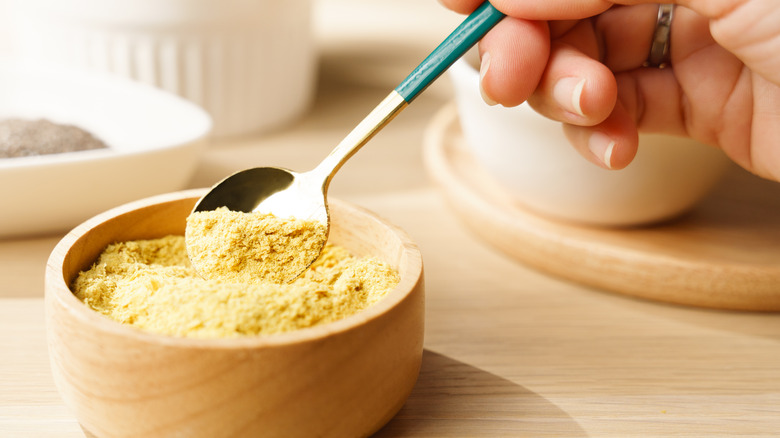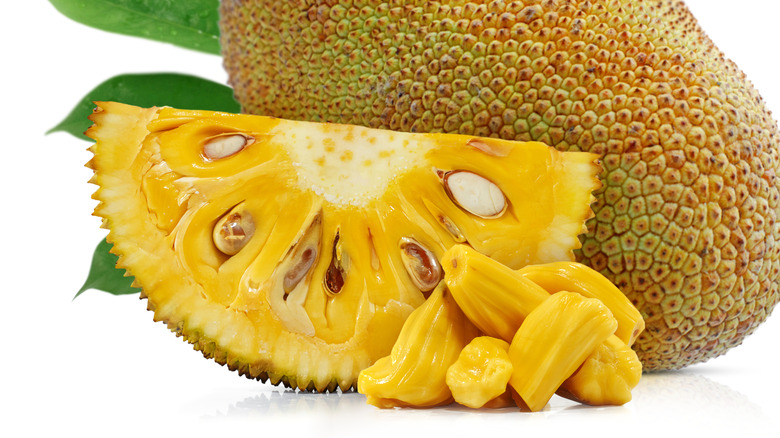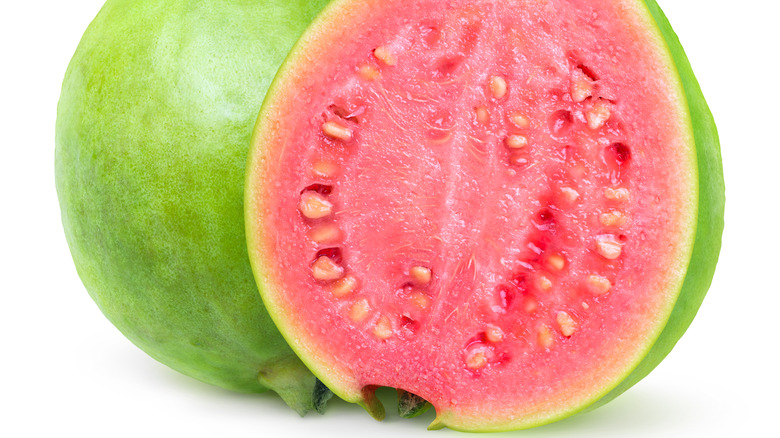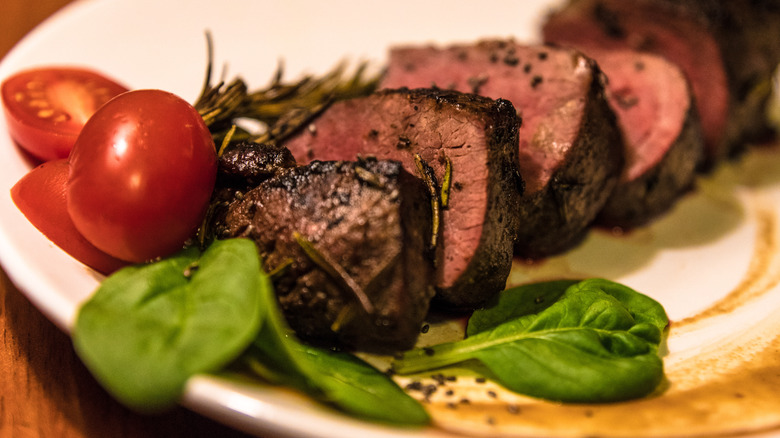Uncommon Foods That Are An Excellent Source Of Protein
All plant foods contain protein, some more than others (via The Old Farmer's Almanac). Beans, peas, and lentils are some of the most protein-dense plant sources, providing an ample 15 to 20 grams of protein per serving. Other protein-rich plants are quinoa, tofu, and edamame, all of which are complete proteins. And did you know that in terms of protein content, pistachios and peas have 6 grams per ounce and 8 grams per cup, respectively?
That said, there are some uncommon foods that are excellent sources of protein, too. From fermented products and fruits to unexpected food sources, you'll find some good reasons to go beyond your typical protein choices. In addition to the quality of protein, some of these are more sustainable than the more traditional meat and dairy products we turn to for our protein needs. (With that said, there are some unique meat options on this list as well.) Read on to discover some of the less common but versatile protein-rich foods.
Crickets
Yep, we're starting off this list with Jiminy Cricket's cousins. You can eat them whole, raw, or roasted, season them with sweet or savory spices, or even dip them in chocolate (via Exoprotein). But you may prefer them processed and finely ground into flour or powder to add to your recipes and boost the protein content of your favorite foods. You'll get 11 grams of protein with just 2 tablespoons of cricket flour (via CricketFlours.com).
Crickets are not only an excellent source of protein; they also contain a good deal of heart-healthy monounsaturated and polyunsaturated fatty acids, according to a 2020 review in Frontiers in Nutrition. So, what do they taste like? They have the flavor of roasted nuts with the essence of shrimp, according to Chef Perry for Exoprotein, which is why they may be a good substitute for nuts in a savory dish, soup, or stew. But if you are allergic to shellfish, please skip this option, because their exoskeleton can cause a similar allergic reaction (per a 2019 study in Molecular Immunology).
Still not convinced? As it turns out, eating crickets is a sustainable choice for the environment, as raising them for consumption requires considerably fewer resources than typical livestock (via Exoprotein).
Inca nut
Walnuts, almonds, and pistachios are nutty nutritional superstars, and not just for their rich antioxidant value. Their protein content per ounce is 4 grams, 6 grams, and ~6 grams, respectively. But if you are looking for an even more protein-rich option, consider the relatively lesser-known Inca nut (also called the sacha inchi seed). It's got a whopping 30 grams of protein per 100 grams, or about 8.5 grams of protein per ounce (via the USDA).
Plukenetia volubilis is a mildly woody plant with heart-shaped leaves, which are edible and can be used for tea (via Echo Community). But it's the oval seed of the star-shaped fruit that is responsible for much of its protein content, according to a 2022 review in Heliyon. In fact, up to 30% of the seed is protein, with a wide variety of amino acids. The seed also contains a good concentration of heart-healthy fats, and is a decent source of omega-3s.
Once the oil has been extracted from the seed, the remainder is processed into flour, which can be incorporated into various foods and beverages (via Echo Community). The seeds may be left whole and roasted or boiled for consumption. Don't eat them raw, though, because they contain considerable amounts of alkaloids, lectins, and saponins, which can be toxic (via Nutrition Advance). Fortunately, the cooking process destroys them, making Inca nuts safe to eat when properly prepared.
Spirulina
If you need a natural dye for your eats and treats, spirulina might be just the thing. With its bright blue-green hue, it can make an otherwise bland-looking dish a festive-worthy treat. What's more, it's got 4 grams of protein per tablespoon (via USDA)! The protein-dense spirulina comprises all nine essential amino acids; it is high in fiber, too, according to a 2022 review in Molecules.
So, what exactly is spirulina? It is considered to be one of the most ancient forms of algae on Earth (via WebMD). Today, you can find it in powdered form as a nutritional supplement. And yes, it can temporarily stain your fingers and tongue with its bright blue-green pigment. But it's got bang for your nutritional buck. While low in calories, it is a potent source of micronutrients, including B vitamins and magnesium. What's more, it contains a key plant protein and antioxidant called phycocyanin, which gives it a deep-sea hue. Its potential benefits include immune-boosting properties, decreased inflammation, and factors that may improve heart health (cholesterol-lowering properties and reduced triglycerides).
Unlike some supplemental powders, you won't likely be able to just mix it with water. Because of its bitterness, you'll want to pair it with something sweet like a juice or blend it into a smoothie (via WebMD).
Seitan
Ever heard of seitan? Don't judge this food based on its hellish-sounding name – though you may have a devilish experience with this gluten-derived product if you don't know how to prepare it.
Seitan, a plant-based meat substitute, has a chewy texture that is similar to chicken (via Food Network). It's got a whopping 21 grams of protein per 3-ounce (85-gram) portion, per the USDA. It is made from gluten, the main protein in wheat, which gives it a protein-rich density. You can slice, dice, or crumble it for a meatless yet protein-rich meal. Moreover, it absorbs other flavors quite well, making it a versatile eat (via Food Network).
Since seitan is bland, it may not be so palatable on its own. Overcooking will make it rubbery (via Veganuary). So, be sure to use low heat and season it well. For soups, you'll want to simmer it, but you can pan-fry or sauté it for a stir-fry. Because it is made with vital wheat gluten, you may want something to tenderize it, according to My Quiet Kitchen. Thus, a marinade can work quite well. Consider using a bit of oil with something flavorful, acidic, and tangy like soy sauce and/or vinegar.
Quorn
Whether or not you are a fan of fermented foods, you may want to consider trying Quorn, a plant-based meat substitute derived from a fungus (via BBC Good Food). Before you balk at that, consider that mushrooms are a fungi food. To make the meat substitute, a naturally occurring microfungus called Fusarium venenatum is fermented (similar to yogurt or beer). This fermentation process forms a mycoprotein, a pale yellow solid mound that contains all nine essential amino acids (making it a complete protein).
This mycoprotein is also high in fiber, contains little sat fats, and has no cholesterol, according to Food Navigator. What's more, it is a sustainable food choice, as the production for mycoprotein requires significantly less land and water than what it takes for other livestock. But if you are watching your processed food intake, note that Quorn is a highly processed meat substitute (via Runner's World). So, if you want meatless, diced "chicken" pieces or ground "beef," read the label and choose a variation with minimal additives and saturated fats.
Hemp seeds
Don't underestimate the value of seeds. They can elevate the overall appeal of your dish while adding a nutritional boost. Plus, you have plenty of seeds to choose from; think sesame, poppy, sunflower, and many of your favorite nuts, which are technically seeds. But you might be missing out on some quality protein if you haven't used hemp seeds.
Hemp seeds are tiny, lightly crunchy seeds that are slightly sweet with a nutty-like flavor. Though derived from the cannabis plant, most hemp seeds contain none of the psychoactive TCH found in marijuana, according to Medical News Today. But the things they do have are quite beneficial: They are a source of anti-inflammatory omega-3s, dietary fiber, and protein. In fact, just 3 tablespoons of hemp seeds provide close to 10 grams of protein. Even better, these seeds are a complete protein.
Like other seeds, hemp seeds can be quite versatile. Sprinkle hemp seeds into your salads, use them as a garnish for your smoothie bowl, or mix them into your yogurt or cottage cheese. Or, if you are in the mood for dessert, they can be a great substitute for the nuts you sprinkle over your banana split or ice cream.
Wheat berries
Nope, wheat berries aren't berries; they are whole grain kernels with their endosperm, germ, and bran intact, according to Food Network. They are often processed into the flour we use for breads and other baked goods, but they can also be enjoyed in their whole form.
Once cooked, wheat berries may appear similar to plump short-grain rice; they impart a slightly nutty taste and chewy texture. This makes them an ideal swap for whole grains like rice or even steel-cut oats. They may also be enjoyed in hearty dishes like stews or chili, mixed into salads, and combined with dried fruit. What's more, they can elevate the protein in your morning meal. So, serve it up with a large egg. Or consider using wheat berries for your breakfast porridge; these grains have as much protein as oat groats (steel-cut or Irish oats) and nearly twice as much protein as rolled oats and brown rice. Just one-fourth cup of hard red winter wheat berries contains 6 grams of protein and ~6 grams of fiber (via USDA). By comparison, the same amounts of rolled oats and brown rice, raw, have >3 grams and ~3.5 grams of protein, respectively.
Tiger nuts
Tiger nuts have plenty of monikers, including earthnuts, chufa nuts, and Earth almonds (via Cleveland Clinic). These striped, marble-sized morsels have existed for centuries, but they aren't actually nuts. In fact, they are root vegetables, just like potatoes and beets. They are much smaller, though, which makes them look more like nuts than tubers.
Nutritionally, tiger nuts are high in dietary fiber, with a whopping 10 grams per ounce. They have vitamin C and E, making them good for immunity-boosting. Their macronutrient profile includes carbs, healthy fats, and protein. Interestingly, an ounce of tiger nuts has only 2 grams of protein; however, considering that they contain 18 amino acids — including lysine and glycine — they are actually on par with eggs.
You can enjoy tiger nuts raw or roasted for a crunchy snack. They are also boiled and processed into milk, or incorporated into Spanish horchata, a sweetened "nut" milk.
Nutritional yeast
Nutritional yeast (or nooch) may not sound appealing to the typical American, but the English have relied on it for close to a century. Chemists knew of its benefits dating back to the early 1900s (via Britannica). A waste product from brewing, this leftover yeast was manufactured by the English into Marmite to serve as both a nutritional supplement and a spread (e.g., jam). In the 1950s, it started being commercially manufactured as nutritional flakes in the United States.
Its savory, nutty, and cheesy flavor makes it a suitable ingredient for vegan cheese. It can also be sprinkled onto popcorn, added to pasta dishes as a substitute for parmesan cheese, scrambled into eggs, or added to soups for an added "cheesy" flavor and a powerful boost of nutrients. One teaspoon of nutritional yeast is low in calories but a great source of micronutrients, including vitamins B6 and B12 (if fortified), both providing over 200% of your daily value (via Medical News Today). It is also a good source of protein, with all nine essential amino acids, per WebMD.
With that said, nutritional yeast isn't exactly for everyone. If you have hypertension, glaucoma, or inflammatory bowel disease (IBD), it can worsen your symptoms (via Medical News Today). It's also not recommended for anyone with risk for gout.
Jackfruit
Have you ever heard of jackfruit? Because of its neutral flavor and stringy texture, it's perfect for mimicking pulled pork or chicken, registered dietitian Gillian Culbertson told the Cleveland Clinic.
While protein isn't notable in most fruits, jackfruit may be a good exception. With nearly 3 grams of protein per cup (via USDA), jackfruit contains more protein than berries, kiwi, oranges, and nectarines, according to Cook Unity. It is also a source of vitamin B6 (via Cleveland Clinic), which is great for protein absorption. This B vitamin aids in digestion by helping enzymes break proteins into essential amino acids for travel through the blood stream.
You'll likely find jackfruit ready to eat, peeled and cut into chunks, and sold in the canned goods section in certain markets. It can be packaged in water, brine, or syrup (via Jack & Friends Jerky). Trader Joes, Whole Foods, Walmart, and other larger retailers may carry it. Alternatively, you can find it online.
Guava
Few people think of grabbing a piece of fruit when they need some good ol' protein. But the guava may be an exception, as you'll get a surprising 4 grams of protein per cup. That's as much protein as some veggie burgers, and only slightly less than an egg. One cup of this fruit also has 9 grams of fiber.
While it has no superfood status (at least not yet), it is packed with heart-healthy nutrients. This fruit is a rich source of immune-boosting vitamin C and blood pressure-regulating potassium, according to Pharmeasy. It also contains important nutrients for eye health, including vitamin A and lycopene, as well as various other antioxidants.
As far as taste goes, guava's flavor is described as a cross between a strawberry and a pear, according to WebMD. The fruit is soft and all-around edible; you can eat the whole thing from skin to core. However, you may want to skip the seeds if you don't like the more pungent taste of papaya (via HealthierSteps).
Emu
If you love the taste of beef, we have some good news. Emu meat tastes similar to cow's meat (beef) but is lower in cholesterol, fat, and calories (via Uniquely Emu). Additionally, it has less sodium and more potassium, which can make it a good option for keeping your blood pressure in check. As for protein, you'll get 22 to 23 grams per 3.5-ounce portion. By comparison, the same amount of lean ground beef has 17 grams. In fact, it's even higher in protein, iron, and vitamin C, which aid in iron absorption.
Australians have had considerable experience in consuming emus (related to the ostrich), for many centuries. So why not give it a try. Not only will it satisfy your beef cravings, but you may also discover that its tenderness makes it a quite pleasant and versatile choice. Enjoy it as you would beef — grilled, baked, roasted, sauteed, braised, or pan-fried — but be sure not to overcook or it may become dry. Uniquely Emu suggests cooking no longer than a medium rare stage – pink and red in the center. Remember, it will continue to cook even out of the oven.
Kangaroo
Though served as a meat substitute in some of Australia's higher-end restaurants, kangaroos are reportedly regarded as more of a pest than an option for meat in the country, according to The Meat and Wine Co. Moreover, you're unlikely to find it on American menus (or in many other parts of the world, for that matter). With that said, you can buy kangaroo meat in San Francisco and New York, or you can order it online.
So what makes the kangaroo a viable, protein-rich option? Aside from being a surprising source of omega-3s, kangaroo meat has other benefits: Its meat is quite lean (clocking in at just 2% fat), it has a protein content that's slightly higher than beef, and it is also high in iron. However, it is quite gamey and more pungent than lamb or beef.
In terms of sustainability, kangaroos consume considerably less food and water compared to other livestock. And because they aren't farmed, there is no human intervention in the process, meaning they are free-range with no hormones or antibiotics.


